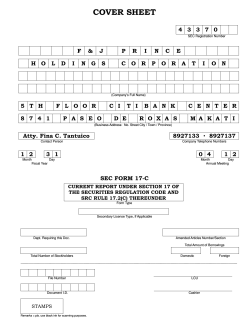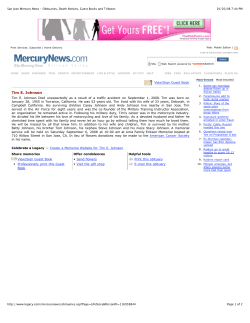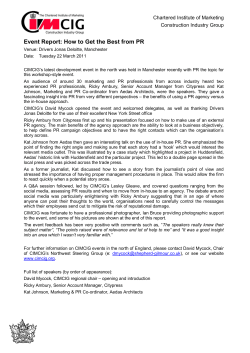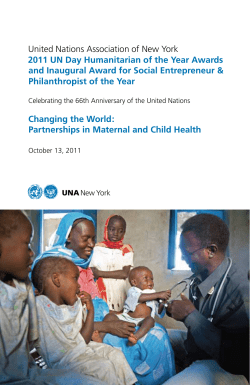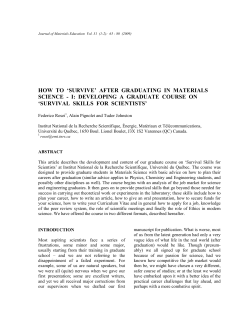
How to Implement Peer Learning in Your Classroom Jennifer Johnston
Resource & Research Guides Vol. 1 #7 2009 How to Implement Peer Learning in Your Classroom Jennifer Johnston What is Peer Learning? Peer Learning is a teaching and learning strategy that involves groups of students working together to solve a problem, complete a task, or create a product. Each member of a team is responsible not only for learning what is taught but also for helping team-mates learn, thus creating an atmosphere of achievement. Students work through the assignment until all group members successfully understand and complete it. Why use Peer Learning? Research has shown that Peer Learning techniques: Promote student learning and academic achievement. Increase student retention. Enhance student satisfaction with their learning experience. Help students develop skills in oral communication. Develop students' social skills. Promote student self-esteem. Help to promote positive race relations. Preparing for Peer Learning Many students have learned with and are accustomed to a traditional teaching style. Good planning and preparation are essential to a successful Peer Learning (PL) lesson (Johnson et al. 1994). The success of the PL lesson is largely dependent on two factors: factor, the problems must promote higher order thinking and critical analysis. Not just ‘plug into a formula’ problems. What Makes Peer Learning Work? Simply putting students in groups and telling them to work together does not mean they know how to work cooperatively. Working cooperatively is much more than being physically near other students. Johnson et al (1990) state that five elements must be included for a lesson to be cooperative. These five elements include: 1. positive interdependence, 2. face-to-face promotive interaction, 3. individual accountability, 4. social skills, and 5. group processing. Basic Elements of Peer Learning 1. Positive Interdependence – A group member can’t be successful without the other members also being successful. The problems need to be structured in such a way that, students need each other (sink or swim together) to complete the task and to maximise their learning. This can be achieved by: using shared resources, getting the students to agree on a single, consensus answer from the group, one set of material for the group. Formation and maintenance of wellfunctioning groups The type of problems the students are asked to solve. 2. Individual Accountability – each group members effort is needed, there is no ‘hitchhiking’. Teachers structure individual accountability by having the group learn together but give individual tests, checking the learning of individual group members at random, or assigning the role of checker to each group. For the first factor, PL groups are structured and managed to maximise the active and appropriate participation of all students in the group (Johnson et al. 1994). The second 3. Face to Face Promotive Interaction group members promote other’s learning by helping, sharing and encouraging efforts to learn. Students need to be knee-to-knee and 1. 2. 1 © Jennifer Johnston & NCE-MSTL, 2009 Resource & Research Guides Vol. 1 #7 2009 eye-to-eye to explain, discuss, teach and encourage specific cooperative behaviours. 4. Interpersonal and Small Group Skills – The teacher needs to continually define, teach and encourage specific cooperative behaviours (i.e. leadership, trust-building, communication, decision-making and conflict resolution) by stating expectations, assigning roles, and giving specific feedback. 5. Monitoring, Intervening and Processing – Group members need to be aware of how their group is functioning. While students work in Peer Learning groups, the teacher monitors their work and interactions and occasionally intervenes to improve teamwork and task work and help groups with strategies. Formation and Maintenance of WellFunctioning Groups Numerous issues relating to the formation and maintenance of well functioning groups are explored by Johnson et al. (1994). These preinstructional decisions include group size, ability grouping, seating arrangements, role assignments, group self-evaluation, group testing and individual testing and are all found to contribute to the performance of the groups. Group size and ability grouping For students to work together, they must be assigned to groups. To assign students to groups, the teacher must decide how large a group should be, how students are assigned to groups, how long the group will stay together and what combination will be used during the lesson. There is no ideal size for a Peer Learning group. The typical size of a Peer Learning group ranges from two to four. Johnson et al. (1994) advise to follow the basic rule of thumb, the smaller the better. When forming groups there are several factors that need to be considered, such as the following: b) c) d) e) f) g) for acquiring and processing information increases. The shorter the period of time available the smaller the learning group should be. The smaller the group, the more it is for students to hide and not contribute their share of the work. The larger the group, the more skilful group members must be. With increasing group size, there is a decrease in face-to-face interaction among teammates and a reduced sense of intimacy. The materials available or the specific nature of the task may dictate a group size. The smaller the group, the easier it is to identify any difficulties students have in working together. (Johnson et al. 1994) The benefits of groups of three or four are numerous. This group size is large enough for the generation of ideas and approaches, but small enough that all members can contribute to solving the problems and the situation of a ‘hiding’ student is diminished (Johnson et al. 1994). There is no ideal method of assigning students to groups. A groups teamwork skills determines a group’s productivity. Johnson et al. (1994) recommend that the teacher assigns the groups. This can be done a number of ways, at random, by ability, either mixing the abilities or groups of the same ability. Whatever suits the task. Seating arrangements The physical arrangement of the classroom differs greatly to the traditional ‘facing the teacher’ arrangement. Where possible students should sit in a horse shoe shape, ‘knee-to-knee and eye-to-eye (Johnson et al. 1994), while all the groups face in a similar direction towards the front of the room or towards the blackboard, as illustrated in a) As the size of the learning group increases, the range of abilities, expertise, skills and the number of minds available 2 © Jennifer Johnston & NCE-MSTL, 2009 Resource & Research Guides Vol. 1 #7 2009 Figure 1 below. Blackboard Student Figure 1 Illustrates students in groups of three, in a ‘horse shoe shape’, while all facing in a similar direction towards the blackboard or the teacher. This arrangement promotes communication between each member of the group and has a positive influence on the functioning of the PL groups. The groups leave space between them and the other groups. So they do not interfere with each other, and to allow the teacher to circulate the room with ease. This seating arrangement is flexible enough to allow students to move quickly if they need to. For example from working in pairs to working in three’s or four’s (Johnson et al. 1994). Role assignments As the majority of students are not accustomed to or skilled in group roles, assigning specific roles that students are to perform during the lesson helps ensure positive interdependence. In addition to their responsibility to learn, each group member can be assigned a responsibility to help group members work together effectively. The following is a description of the individual tasks within a group. Group Roles Facilitator -makes sure everyone understands each worksheet question before the team begins to discuss it, encourages everyone to participate, helps the group reach consensus. Monitor - keeps everyone on task, monitors time, moves the group along to assure that the tasks are done in the allotted time. Recorder - writes down the group's consensus answers to the questions. Reporter - makes sure the group discusses how it functioned, reports the group's answers during the class discussion. Group roles can be rotated so that each group member plays each one several times. At times there can be students who refuse to participate in a cooperative group or who do not understand how to help the group. This problem can be solved or prevented when each group member is given a specific role to play in the group. Roles are assigned when each person is given a specific task or problem (Johnson et al. 1994) Group testing and individual testing ‘What children can do together today, they can do alone tomorrow’ (Vygotsky 1978) Group accountability is structured by assessing the overall performance of the group and giving the results back to group members to compare to a standard of performance. Common ways to structure individual accountability include: Keeping the size of the group small Give an individual test to each student. Give random individual oral examinations. Observe each group and group member. Assign one student in each group the role of checker of understanding. Have students teach what they learned to someone else. Have group members edit each other’s work. Have students use what they have learned to solve a different problem. (Johnson et al. 1994) Specified desired behaviours: The following is a list of activities required by each group member. Each member should be able to explain how to arrive at the answer. Each member should be able to relate what is being learned to previous information learned. Everyone in the group should comprehend the material and agree with the answers. 3 © Jennifer Johnston & NCE-MSTL, 2009 Resource & Research Guides Vol. 1 #7 2009 Everyone participates. Each listens accurately to what other group members are saying. Members do not change their minds unless they are logically persuaded (majority rule does not promote learning). Criticise ideas, not people. Promoting Effective Problem Solving The types of question used in the lesson have a major impact on the group and individual learning outcomes. Good questions (Concept questions) require the student to decide what concepts and principles should be applied to the problem and not just simply answer the question by deciding on what formula to use. Problem solving approach/strategy Some guidelines on how the student could breakdown the problem into manageable pieces are as follows: • Evaluate the problem, characterise it, and identify components that are familiar to you. • Identify what you do know about the problem and what you do not know. • Allocate the group’s time; specifying which group member will do which task. • Reform the group and share the knowledge each has gained. • Collect the group’s information and bring it to bear on the problem. Solve the problem. • Reflect on the knowledge gained from the problem and how the group functioned in evaluating the problem. (NISE 1997) Concept questions are often seen as difficult for even the best students as they involve applying concepts and making decisions. However, they make ideal PL questions as the group can work together, pool their ideas and share the problem. For Example, Q1. If you drop an object in the absence of air resistance, it accelerates downward at 9.8 m/s2. If instead you throw it downward, its downward acceleration after release is a). less than 9.8 m/s2. b). 9.8 m/s2. c). More than 9.8 m/s2. Learning Strategies There are many learning strategies that can be used in a PL lesson. Here is an example of two of these strategies: Think-Pair-Share In Think-Pair-Share is where the teacher poses a challenging or open-ended question and gives students a minute or two to think about the question individually. Students then pair with a cooperative group member or neighbour sitting nearby and discuss their ideas about the question for several minutes. After several minutes the teacher solicits student comments or takes a classroom "vote." Students are much more willing to respond after they have had a chance to discuss their ideas with a classmate because if the answer is wrong, the embarrassment is shared. Discovery Method This method is similar to the structured problem solving method except that student teams are asked to find the information they need to solve the problem on their own without the benefit of a mini-lecture. The instructor can structure a multi-layer discovery task. This method ensures that groups that work faster than other groups can delve more deeply into the problem. References: Johnson D. W., Johnson R.T., and E. J. Holubec, (1994) The Nuts and Bolts of Cooperative learning, Edina: MN: Interaction Book Company. Johnson D. W., Johnson R.T., and E. J. Holubec, (1986) Circles of Learning: cooperation in the Classroom, Edina: MN: Interaction Book Company. NISE (National Institute for Science Education) – College Level One, (1997) Collaborative Learning: Small Group learning Page [online], available: http://www.wcer.wisc.edu/archive/cl1/cl/ [accessed 27 August 2009] Peer Learning website resources: Collaborative Learning: small group learning: http://www.wcer.wisc.edu/archive/cl1/cl Cooperative Learning Centre: http://www.co-operation.org/ Ms Jennifer Johnston Senior Projects Officer in Teaching and Learning (Physical Sciences) NCE-MSTL E-mail: Jennifer.Johnston@ul.ie 4 © Jennifer Johnston & NCE-MSTL, 2009
© Copyright 2025







